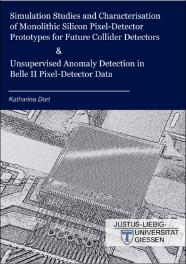| dc.contributor.advisor | Lange, Jens Sören | |
| dc.contributor.author | Dort, Katharina | |
| dc.date.accessioned | 2022-06-09T08:13:28Z | |
| dc.date.available | 2022-06-09T08:13:28Z | |
| dc.date.issued | 2022 | |
| dc.identifier.uri | https://jlupub.ub.uni-giessen.de//handle/jlupub/1255 | |
| dc.identifier.uri | http://dx.doi.org/10.22029/jlupub-1097 | |
| dc.description.abstract | Present and future high-energy physics experiments pose challenging demands on the detector systems and analysis methods. This dissertation addresses both aspects by focusing on the optimisation and characterisation of a novel technology demonstrator for a monolithic silicon sensor design and the development of model-agnostic analysis techniques for the pixel detector at the Belle II experiment.
In the first part, the requirements of vertex and tracking detectors for future Higgs factories such as the Compact Linear e+ e− Collider (CLIC) or the Future Circular e+ e− – Collider (FCCee) are addressed. The experimental conditions at these colliders require high-precision sensors with a low material content. The CLIC Tracker Detector (CLICTD) is a technology demonstrator for a monolithic pixel sensor fabricated in a modified 180 nm CMOS imaging process that targets the requirements of the CLIC tracker. The performance of the sensor is assessed for different operation conditions, pixel designs and wafer materials. A spatial resolution down to (3.9 ± 0.2) µm, time resolution down to (4.8 ± 0.1) ns as well as a hit detection efficiency >99.7 % over a wide range of detection thresholds is observed and the CLIC tracker requirements are found to be fulfilled.
Modern silicon sensors such as CLICTD incorporate complex sensor designs that are challenging to simulate and model. This dissertation presents a combination of electrostatic finite-element and transient Monte Carlo simulations to provide simultaneous access to precise sensor modelling and high-statistics simulation samples. The advanced simulation approach is validated against data and excellent agreement is found over a wide range of different operation conditions.
In the second part, patterns of minimally-processed pixel hits recorded by the Belle II pixel detector are investigated. In particular, a focus on model-agnostic approaches is placed that enable an unbiased exploration of data, while filtering out anomalous detector signatures that could hint at new physics scenarios. The identification of hypothetical magnetic monopoles against Belle II beam background is presented using Self-Organizing Kohonen Maps and Autoencoders. The two unsupervised algorithms are compared to a convolutional Multilayer Perceptron and a superior signal efficiency at high backgroundrejection levels is found for the unsupervised techniques. | de_DE |
| dc.language.iso | en | de_DE |
| dc.rights | In Copyright | * |
| dc.rights.uri | http://rightsstatements.org/page/InC/1.0/ | * |
| dc.subject | Hochenergiephysik | de_DE |
| dc.subject | Siliziumsensor | de_DE |
| dc.subject | Machine Learning | de_DE |
| dc.subject.ddc | ddc:530 | de_DE |
| dc.title | Simulation Studies and Characterisation of Monolithic Silicon Pixel-Detector Prototypes for Future Collider Detectors & Unsupervised Anomaly Detection in Belle II Pixel-Detector Data | de_DE |
| dc.type | doctoralThesis | de_DE |
| dcterms.dateAccepted | 2022-06-06 | |
| local.affiliation | FB 07 - Mathematik und Informatik, Physik, Geographie | de_DE |
| thesis.level | thesis.doctoral | de_DE |



